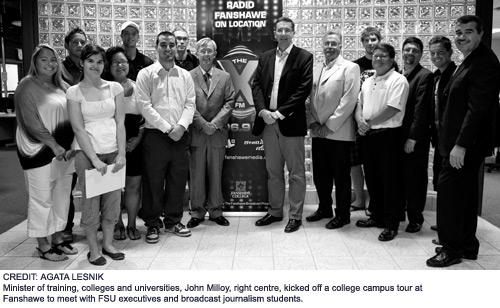Minister talks investment in post-sec education

Minister of training, colleges and universities, John Milloy, made Fanshawe the first stop on his current tour of schools. The Fanshawe Student Union executives and broadcast journalism students were on hand to meet and question the minister on the future of post-secondary education.
Milloy is visiting schools to promote the successes of post-secondary education and the government's goals before students begin to return.
One particular goal of the provincial government is to have 70 per cent of Ontarians with a post-secondary credential, whether it is an apprenticeship, college diploma or university degree, so graduates are prepared for the new job market.
“Over the past five or 10 years, there have been changes to our economy. Jobs will be high value jobs that require training past high school,” he said.
Milloy made mention of Reaching Higher, the government's investment plan into postsecondary education from 2005, noting it as the “largest single investment in post-secondary education in 40 years.” That investment was $6.2 billion.
The result of Reaching Higher is that “a lot more people are going to colleges, universities and training opportunities,” he said. There will be approximately 200,000 new students this year and they're from a diverse background, from first generation students to aboriginal and students with disabilities.
He also touted the government's efforts to make education more affordable in terms of the changes made to OSAP. Students are now able to earn $100 a week instead of $50. However, work-study programs will not see an increase in how much students can earn, but that could be a topic discussed for the 2011 to 2012 term, Milloy said.
Also, now when students finish school they are interest-free for six months, which the minister said is sufficient time to decide a career path.
Students can also be part of the repayment assistance plan. After the allotted six months, their payments for outstanding loans is then based on their ability to pay and it will never go above 20 per cent of their family's income. But if the payments are unable to be made in the first five years, the government will pay the interest.
Individuals can be part of the system for 15 years, and if they are unable to pay, the government will take care of the loans.
Additionally, much of the frustrating paperwork relating to OSAP — such as the Access Grant and Distance Grant — will be removed and the funds will be deposited straight into students' accounts.
With more access to post-secondary education, the number of students graduating from college has gone up from the 57 per cent in 2002 to 2003 to 65 per cent.
However, in 2009, 85 per cent of 2008 to 2009 graduates were employed within six months of graduation — a number usually in the nineties.
Milloy was quick to emphasize one of the “worst years financially” as part of the reason behind the number. He added the government is looking at the “quality of education” and equipping students with the right training for the job market. “Part of it is ensuring they receive education that is relevant,” he said.
Despite the gains in education, the provincial government is striving to improve the post-secondary education system.
“We've accomplished a lot in our post-secondary education system, and I'm not here today to say it's perfect,” he said. “I'm here to say there's a lot that needs to be done.”













